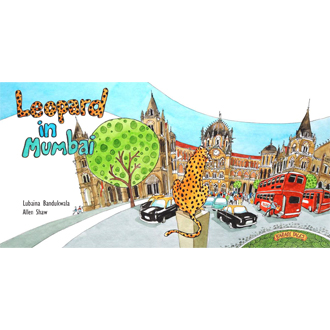Leopard in Mumbai: What it’s Like on the Other Side
Our editorial intern, Nandini Ranganathan, introspects after reading Leopard in Mumbai, written by Lubaina Bandukwala and illustrated by Allen Shaw.
When we envision a wild animal making its way into public places, we often panic. Self-preservation kicks in at the very thought of being in danger, and that’s alright. But, how often do we stop to think about the imaginary animal and what it’s going through? If we had a scorecard of advantages in such a scenario, the animal would just have the “wild” factor playing in its favour, while we – the humans – would have more: sheer number, familiarity with our surroundings, makeshift lethal weapons and so on.
Lubaina Bandukwala’s Leopard in Mumbai triggers this introspection.
Leopard leaves from Sanjay Gandhi National Park (SGNP) one morning to explore Mumbai and everything it has to offer. Mumbai doesn’t disappoint. We soak in the vivid water-washed scenes (pun intended) visualised by Allen Shaw and vicariously visit Mumbai through Leopard and her exploits.
She checks a number of things off her proverbial bucket list – travelling on the local train; visiting the Mount Mary Church Festival; taking in the sights of the Chowpatty Beach, Haji Ali Mosque and the Babulnath Temple; and snacking on the world-renowned chaat of Mumbai. When she finally reaches India Gate – her intended destination – and faints, our hearts reach out to her. We yearn for her to get better and anxiously read on, hoping all is well.
Inspired by real-life incidents in the areas closest to SGNP, the book – most suited for children aged 7 to 9 – helps us look at the world through Leopard’s eyes and read her thoughts. Thoughts that tell us that she means no one any harm. Although that might not always be the case in real life, we learn that we’re not helping ourselves – or the leopards – by causing a ruckus.
Other subtle hints are peppered throughout the book, provided we know where to look. At the school that Leopard visits, the children are unafraid and excited; but the grown-ups, with all their preconceived notions, back away from Leopard. The adults who had run pell-mell at the sight of Leopard only dare to come close when she is down. These incidents, when seen through Leopard’s eyes, make us question our actions and wonder if we have been too harsh in judging our wild friends.
A delightful experience from start to end, Leopard in Mumbai nudges us to think about our apprehension even as we’re left with a smile, awestruck at the simplicity of its concept.






